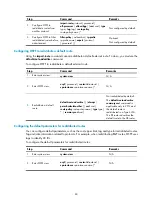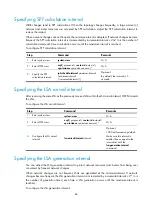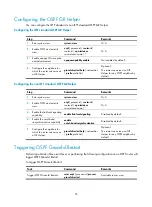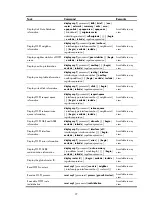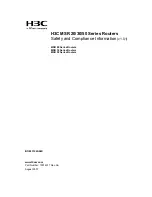
84
Step Command
Remarks
3.
Configure the default
parameters for
redistributed routes (cost,
upper limit, tag, and
type).
default
{
cost
cost
|
limit
limit
|
tag
tag
|
type
type
} *
Optional.
The default cost is 1, the
default maximum number
of routes redistributed per
time is 1000, the default
tag is 1, and default type
of redistributed routes is
Type-2.
Advertising a host route
Step Command
Remarks
1.
Enter system view.
system-view
N/A
2.
Enter OSPF view.
ospf
[
process-id
|
router-id
router-id
|
vpn-instance
vpn-instance-name
] *
N/A
3.
Enter area view.
area
area-id
N/A
4.
Advertise a host route.
host-advertise
ip-address cost
Not advertised by default.
Tuning and optimizing OSPF networks
You can optimize your OSPF network in the following ways:
•
Change OSPF packet timers to adjust the OSPF network convergence speed and network load. On
low-speed links, consider the delay time for sending LSAs.
•
Change the SPF calculation interval to reduce resource consumption caused by frequent network
changes.
•
Configure OSPF authentication to improve security.
•
Configure OSPF network management functions, such as binding OSPF MIB with a process,
sending trap information, and collecting log information.
Configuration prerequisites
Before you configure OSPF network optimization, complete the following tasks:
•
Configure IP addresses for interfaces.
•
Configure OSPF basic functions.
Configuring OSPF packet timers
You can configure the following timers on OSPF interfaces as needed.
•
Hello timer
—Interval for sending hello packets. It must be identical on OSPF neighbors.
•
Poll timer
—Interval for sending hello packets to a neighbor that is down on the NBMA network. The
poll interval is at least four times the hello interval.














